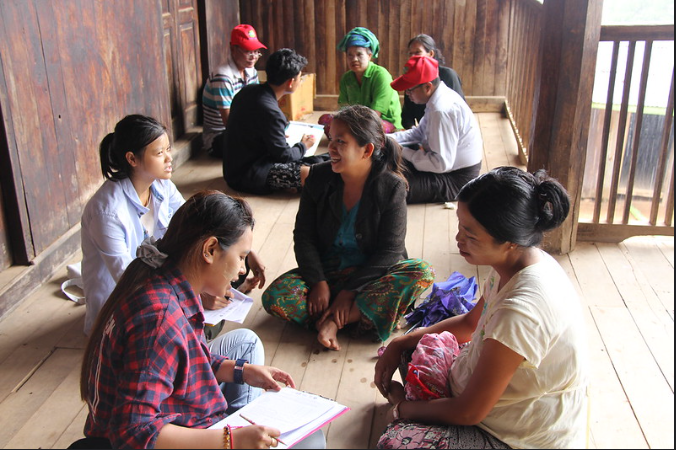By the Institute for Global Environmental Strategies (IGES)

Baseline survey conducted in Lao PDR
© IGES
Majority of the population in the ASEAN region live in riverine and coastal plains that are vulnerable and subject to periodic and extensive hazards such as floods and landslides. This is exacerbated by climate change which has created an urgent need for the people of ASEAN to equip themselves against disasters and promote a priority shift from disaster response to building disaster-resilient communities.
The project entitled Disaster Risk Reduction by Integrating Climate Change Projection into Flood and Landslide Risk Assessment (ASEAN DRR-CCA) demonstrated how this priority shift can be done. It established four River Basin Pilots (RBP) in Lao PDR and Myanmar where ASEAN stakeholders from government agencies, to experts, to local communities participated in flood and landslide risk assessments and mapping, including related trainings. The project engaged and equipped ASEAN local communities with tools and techniques and how they can integrate them into their flood and landslide risk assessments and projections. ASEAN local communities also learned approaches from each other for replication in their respective localities.
Reflecting on the risk assessment and mapping tools, techniques, and approaches they learned from the project, a government official, an expert, and a local community member share their hopes on how ASEAN communities can turn vulnerabilities into resilience. Their reflections also affirm the value-add of community empowerment and inclusive and participatory approaches on top of the tools they were provided to build a disaster management system that works on the community level. Indeed, disaster-resilient communities cannot flourish in an environment where those affected most by disaster and climate risk are excluded.
The tools: simple early warning devices make a huge difference in saving lives

Baseline survey conducted in Lao PDR
© IGES
Bousavanh Vongbounleua, a Technical Officer from the Department of Climate Change of Lao PDR, described one of the pilot sites in Phoukhoun District in Lao PDR, “The village is nestled along the foot of the hills. Access to timely information and assistance remains a challenge.” In case of possible disasters, most villages rely on warnings from their own neighbors. In some instances, village leaders go from door to door to send out the warnings.
Early warning is one of the key disaster risk management tools that can build the resilience of vulnerable communities, especially those prone to periodic and extensive hazards such as floods and landslides. Early warning tools save lives by alerting the people to imminent dangers and empowering them to make decisions that can help protect their lives and livelihoods.
Through the project, the local community in Lao PDR learned that setting up an early warning system like a megaphone or a community speaker can make a lot of difference. Mr. Bousavanh added, “Early warning, when linked to early action can help mitigate the effects of disasters, complementing governmental mandates to protect lives.”

Baseline survey conducted in Lao PDR
© IGES
Inclusiveness: women too can contribute to community risk reduction plans

Daw Ngwe Yin participating in the community-based disaster risk reduction exercise in Myo Ma Quarter, Myanmar
© IGES
Days of heavy rains triggered devastating landslides and flash floods in Myo Ma Quarter in Myanmar. Tons of mud, rocks, and debris from surrounding hills slammed into neighborhoods on the night of 3 August 2019, collapsing walls and filling homes with water and mud. “I have never seen anything like this. The noise was awful, beyond imagination. I am physically blessed to be alive,” said Daw Ngwe Yin, one of the many victims affected by the disaster. She was no longer safe there
When Daw Ngwe Yin heard about the project coming to her township, she immediately persuaded her granddaughter and neighbors to join. Supported by the Japan-ASEAN Integration Fund (JAIF), a community-based disaster risk reduction exercise was carried out as part of the project. This was among the first platforms to bring the community together, including women, to discuss and brainstorm climate-inclusive community risk reduction. Through the project, ASEAN local communities learned from the Myanmar Maternal and Child Welfare Association to prioritise the most vulnerable group – the elderly, mothers with young children, and people with disabilities – when providing quick assistance in time of disasters, especially when there is a need to evacuate them to safer places.

Landslide field survey in Taunggyi, Myanmar
© IGES
Use of local resources: “durian-funding” as a successful model for financing disaster management activities

Case visit in Uttaradit Province of Thailand
© IGES
Collaborative effort is an integral part of the ASEAN DRR-CCA project design. The Uttaradit Province of Thailand was selected as one of the case visit sites. The project’s participatory learning and training courses were designed to expose participants to relevant good practices on landslide risk assessments and mapping. One of these is the locally-established landslide warning system financed by “durian funding.” Dr. Mallika Nillorn, a geology expert from the Department of Mineral Resources of Thailand, explained that “durian funding” encourages villagers to put in two to three durian fruits in a community pool of products to be sold. Sales from the collective durian pool are then put together into a fund used to support disaster management activities.
“Risk reduction measures need to be specific to the risk profiles of particular locations,” Dr. Nillorn shared. Witnessing inspiring achievements through the participatory on-site learning and integrated disaster risk reduction training, she hopes that the “durian funding” model can be replicated and shared across other ASEAN countries.




